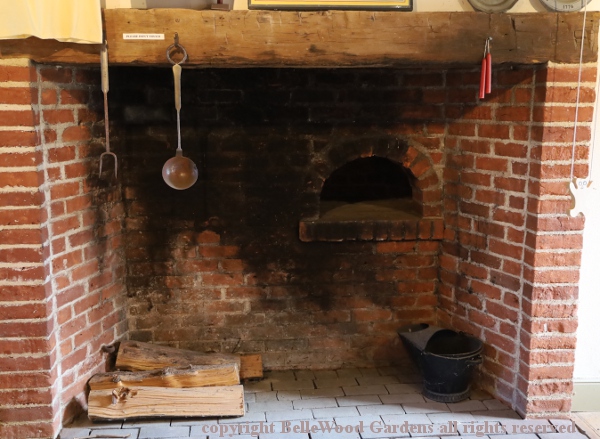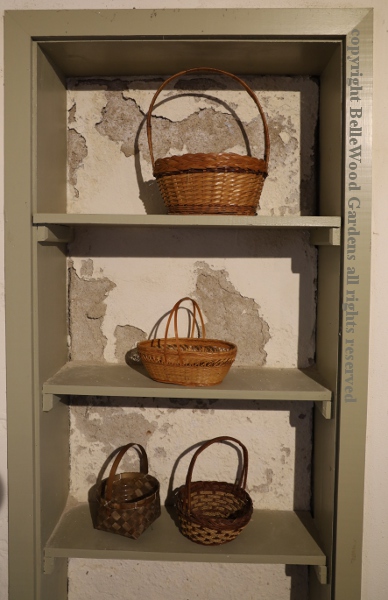 .
.
Back Then: crock of pickles sealed with a pig's bladder. Today: jars of pickles in store's refrigerator case
.
All content included on this site such as text, graphics and images is protected by U.S and international copyright law.
The compilation of all content on this site is the exclusive property of the site copyright holder.
Putting Food By
Saturday, 26 October 2024
 .
.
Back Then: crock of pickles sealed with a pig's bladder. Today: jars of pickles in store's refrigerator case
An afternoon event at the Rockingham Historic Site: "There was no refrigeration in the 18th century, no supermarkets with food flown in from around the world—most people are aware of that. But how did the colonists and early Federalists ensure that there was food in the winter for themselves and their families when most things did not and could not grow (especially in a time of a little ice age)? On Saturday, October 26, 2024, from 1:00 to 4:00 p.m., Susan Plaisted of Heart to Hearth Cookery returns (cheesemaking and ice cream programs) to the Rockingham barn to present “Preserve or Perish: 18th-Century Food Preservation.” Techniques for food preservation will be discussed and presented via actual preserved products, with limited hands on, and augmented with Power Point pictures. This is an on-going program that can be visited at any time throughout the afternoon and for which registration is not required!"

The museum store's exterior view. Stone built. Notice the chimney.

It provides the draft for a walk-in fireplace with a bake oven at the rear.

A cupboard to either side, one of which holds some baskets.
This afternoon's presentation will be in the massive New World style Nevius Dutch Barn rebuilt in 2013 partially utilizing a Colonial-era barn that was originally situated in the nearby town of Middlebush.

image courtesy Bill Woodall all rights reserved
My mother made sweet preserves: jams and jelly. So it was natural for me to do the same when I had a kitchen of my own. I expanded my repertoire to bottling fruit and making pickles. I kept to those sweets and sours that could safely be preserved by processing jars with a boiling water bath. Pressure canning was scary. My mother-in-law told the story of how the lid blew off her pressure canner and embedded itself in the ceiling. Yikes!

My friend Janet ferments cucumbers into pickles in these glass crocks.

She also finishes the pickles in glass canning jars, ditto tomato puree and its water.
When, early in 2020 there was the worry about covid-19. I did some basic prepping Anticipating Saturday's upcoming event I speculated on what might be discussed. Drying, of course. Salting and pickling. Smoking. Sugar preserves well, but sugar was expensive, back in the day. I mentioned Saturday's event on a UK forum. Someone replied that her mother used to salt runner beans. And even after soaking they were objectionably salty. I never heard of salting beans. Drying was always the cheap and easy preservation method used for vegetables. But apparently in the UK salting was common technique. Perhaps their weather is damper and trying to dry beans in pod could have moldy results? Preserving vegetables . . . pickling - sauerkraut. Want to discuss preserving eggs with isinglass? waterglass? I'm having fun and we haven't even attended the event yet!
A friend who grew up on a farm in eastern North Carolina said he had never heard of anyone salting runner beans or any beans for that matter. Helpfully continuing on my quest for information, while having dinner with friends one night he mentioned my bean preservation story. One of the dinner table guests was English, and grew up in south London after the war. She said her mother used to salt runner beans to preserve them. She says she understands that the idea originated with sailors who salted vegetables
to have on long sailing trips. Makes sense, we suppose. But no one knows where the term “leather britches” for the beans came from.
Continuing, I approached Professor David S. Shields, author of Southern Provisions: The Creation and Revival of a Cuisine and Taste the States: South Carolina's Signature Foods, Recipes, and Their Stories. He graciously (and promptly) replied. "The leather britches were not salted, but threaded and hung up to dry. I have heard of putting Kentucky Wonder beans in the salt ferment of sauerkraut; but this was decidedly a local and restricted practice. Hope this helps. The Rattlesnake bean was another bean prepped as a leather britches variety."
Now all I need are some leather britches beans to try cooking them myself. But wait! Everything is available online. On Etsy, for a mere $35 plus $6 shipping I can buy some: "Love the look of this prim Colonial Leather Britches garland. It looks amazing on its own or hung with my dried cranberry raisin garland. In days past, women would string and dry their green beans then rehydrate them for eating during the cold months. Today, they make the perfect primitive garland! Approximately 33" of beans and two 5" loops for hanging (total of 42 - 43"). Please take care when unwrapping as dried beans can be fragile." Food, turned into decoration. Turn about is fair play - I remember cranberries and popcorn strung as Christmas garlands. But after the holidays we did put them out for the birds.
26 October. Well, this afternoon's event was a waste of time. It was supposedly some limited hands on, discussion, and Power Point. Instead it was a lecture to seated audience by very soft voiced somewhat difficult to hear, presenter. She held up a slice of dried parsnip, discussed it. Would hold up a jar, mention its contents, pick up another. I had some concerns about specifics: for example she mentioned that carrots would be sliced, salted for a day, drained, treated with hot vinegar for 24 hours, then drained, reheat the vinegar which was then pour over carrots, again and again. My opinion - straight vinegar, especially when concentrated by repeated boiling, is too strong.
Chicken pot pie - this really put me off. Cook chicken, pot up, bake, seal with layer clarified butter. Supposedly good for several months. I don't think so.
Preserving apricots. A) I have my doubts that 18th century New England farmers were growing apricots. B) She showed image of balance scale with equal weight of sugar and pitted, halved apricots. O.K. BUT her image showed white granular sugar. I am sure that what was available in the 1700s would have been brown sugar in a cone, that needed to be scraped or rasped.
However we had a good time going there and coming back, riding around the sunny autumnal roads looking at old barns and even spotted a root cellar. Will need to come back for pictures. Got back home, had tea and cookies, and that was our day. Ah well.
An aside, were you aware that bottling of food was developed very late in the 18th century. Nicholas Appert began developing a technique for sealing food in bottles and boiling them in water. Eventually, in 1810, winning the prize the French army had offered for a new method to preserve food which Napoleon hoped would keep his troops fed.
On my bookshelves
Preserving Food without Freezing or Canning by the Gardeners & Farmers of Terre Vivante, 6th edition, published in 2007. Interestingly, the book was originally published in France in 1992.
I also have a book: Root Cellaring The Simple No-Processing Way to Store Fruits and Vegetables by Mike and Nancy Bubel, published in 1979 (when it was a Christmas gift, according to the inscription.) We once did have a house with basement finished with sturdy tongue and groove plank walls. There was a door that closed off a set of steps leading up to outside bulkhead doors. Worked very well for storing baskets of apples. I would adjust the chilliness by which step things were on - closer to the metal outside doors or lower down and closer the the basement itself. An acquaintance in the UK described something "built into a hillside, so most of it underground but a domed top visible above ground for access." While it sounds to me more like a root cellar, apparently they use clamps and pits.
Two other publications: Home Preservation of Fruits and Vegetables, from the AFRC Institute of Food Research, which is the Agriculture & Food Research Council, HMSO Publications Centre. I have the 14th edition of 1989. Jams, jellies, marmalades, fruit cheeses and butters, mincemeat, bottled fruit, more sweet fruit preserves, vinegars, pickles, chutneys, ketchups and sauces, drying and salting, freezing, storing fruits and vegetables, some common faults and their likely causes. It cost 4 pounds 95 pence, back then. No idea if it is still available. Easier for you in the UK to find out.
And lastly, back on this side of the pond, Storing Vegetables and Fruits in basements, cellars, outbuildings, and pits. Small pamphlet, home and garden bulletin no. 119 from the U.S. Department of Agriculture. Revised in 1970, slightly revised in 1973. Interestingly, it suggests that an underground cellar can also serve as a storm shelter or a protective shelter against radioactive fallout. Currently, Ukraine is building underground schools to protect against potential radiation issues from
Zaporizhzhia nuclear power plant in the war with Russia.
Back to October Back to the main Diary Page